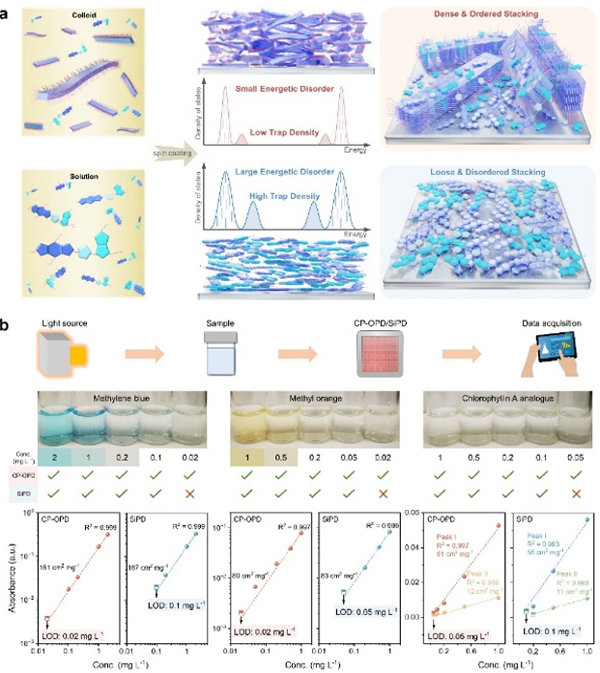Colloid-Processed Organic Photodetector Monitors Trace Water Pollution
Nowadays, nearly 80% of the global population is still at risk of water insecurity, partly due to a lack of access to clean and safely managed water. It is highly desired to identify potential health hazards in water with fast, low-cost, adaptable, and in-situ monitoring methods. The emerging portable organic photodetectors (OPDs) with inherent flexibility and light weight are promising candidates for in-situ water pollution monitoring. However, the unsatisfactory specific detectivity (D*) lower than 1013 Jones makes it difficult for OPDs to meet monitoring requirements set below safety limits (ca. 0.01-0.1 mg L−1) for contaminant discharge.
Recently, a joint research team led by Prof. LIN Yuze, Prof. SHEN Liang and Prof. QIAO Yan from the Institute of Chemisty of the Chinese Academy of Sciences, reported high-detectivity OPDs made from colloid processed polymer semiconductors, which achieve highly-sensitive and accurate monitoring of trace contaminants in water with limits of detection (LODs) below the safety threshold. The study entitled “Highly sensitive water pollution monitoring using colloid-processed organic photodetectors” was published in Nature Water.
Researchers reveal that polymer thin films formed through colloid processing show denser and more ordered stacking, leading to a reduction in energetic disorder and traps, compared to the control films deposited via traditional solution processing. This results in a reduced noise current (in) and improved D* of the corresponding OPDs and the optimized colloid-processed OPDs (CP-OPDs) exhibit a low in of 2.6 × 10−15 A Hz−1/2 and a high D*max of 4.1 × 1013 Jones. The corresponding lowest detectable light intensity standing at 0.12 pW cm−2 at 800 nm, surpasses previously reported emerging photodetectors and rivals or even outperforms commercial silicon photodiodes (SiPDs). Finally, the developed CP-OPDs accomplish highly-sensitive detection of trace dye pollutants and chlorophyllin A analogue in water with LODs of 0.02 and 0.05 mg L−1 (below the corresponding discharge and eutrophication standards), overwhelming the capabilities of commercial SiPDs. This work demonstrates that colloid processing can significantly enhance the D* of portable OPDs across the visible to NIR-II region and enable CP-OPDs to have broader application scenarios for in-situ monitoring of trace pollutants in water relative to those traditional methods, promoting the development of clean water management.

Water pollution monitoring with CP-OPDs made from colloid-processed polymer film (Image by Prof. LIN Yuze)
This work was financially supported by the Strategic Priority Research Program of the Chinese Academy of Sciences, the National Natural Science Foundation of China, and the Beijing Natural Science Foundation.
Contact:
Prof. LIN Yuze
Institute of Chemistry, Chinese Academy of Sciences
Beijing 100190, China
Email: linyz@iccas.ac.cn





